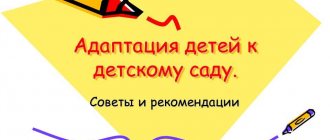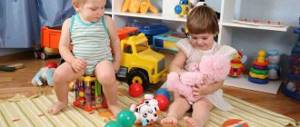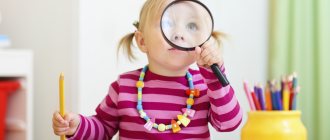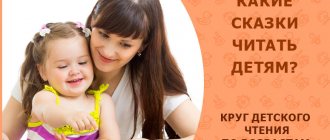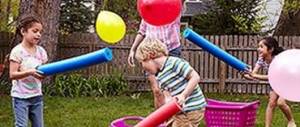Article:
1. WHERE IS THE DOG? Goal: to teach to perceive and distinguish living things from the environment - a dog. Progress of the game An adult organizes the child’s observation of the dog, draws attention to the fact that it runs, barks, eats, wags its tail, it has a head, a torso (body), a tail and paws. The dog can be found on the street with its owner. Then he shows a toy dog, gives him the opportunity to play with it, reads a poem about it, and then with the child looks for an image of a dog in the picture, highlighting it among others: “Here she is, a dog, she can bark - “woof-woof.” 2. “GET TO KNOW THE BIRD” Goal: to teach to perceive and identify living things from the environment - a bird. Progress of the game An adult organizes the child's observation of a bird in a living corner or on the street, drawing his attention to the fact that the bird has a head, a torso (body), wings, legs, it can walk, fly, sing, and peck grains. Then he shows the toy, gives the opportunity to play with it, reads a poem about a bird, performing the actions: Bird, bird, here's some water for you. Here are the crumbs on my palm. Then he and the child search for the image of a bird in the picture, highlighting it among others: “Here she is, a bird, she can fly and sing.” 3. “BEAUTIFUL FLOWER” Purpose : to teach to perceive and distinguish a plant - a flower - from the environment. Progress of the game An adult organizes a child’s observation of a flower during a walk, draws attention to the fact that it grows on the ground, blooms, smells, and decorates nature. He offers to bring it to the group and put it in a vase. After observations during a walk, the teacher shows a flower of a houseplant, invites the child to water it and smell it. Then together they look for the image of a flower in the picture. 4. “SAIL, SHIP!” Goal: to introduce water, highlighting it as an object of inanimate nature. Equipment and material: water pool, floating toys. Progress of the game An adult invites the child to see that there is water in the pool, to touch it with his hands, pays attention to his hands - they have become wet. Then they lower the toys into the water, watching them float, blowing on them, causing movement: “Swim, boat” 5. RAIN Purpose : to teach to pay attention to the phenomenon of nature - rain. Progress of work In rainy weather, an adult organizes observation of this natural phenomenon during a walk. Places a bucket (basin) to collect rainwater. Draws the child's attention to puddles that form after rain, drops of water, clouds from which it rains. He notices that people are walking in raincoats, under umbrellas, and in boots. After observation, the teacher draws clouds and invites the child to draw rain (drip-drip). Then he finishes drawing the puddles and recites poems about the rain: Rain, rain, drip-drip-drip. wet paths. Anyway, let's go for a walk, put on boots 6. “LET'S MAKE A PATH” Purpose : to teach to identify an object of inanimate nature - sand, to develop interest in playing with sand. Material : scoop, bucket, machine. Progress of the game In sunny weather, the adult organizes games with the child in the sandbox. Shows that you can dig sand, put it in a bucket, and build towers from it. Then he gives the child a scoop and offers to pour sand into a bucket. Then together they pour it out of the bucket and build a path for the car. 7. “ZOO” Goal: to continue to teach how to identify objects of living nature, to develop interest in observing their actions and movements. Progress of the game An adult organizes a trip (no more than 30 minutes) to the zoo, where he draws the child’s attention to animals, birds, their habits and movements. After visiting the zoo, he shows pictures of familiar animals and asks to find them by name.
MAGAZINE Preschooler.RF
Summary of the final educational activity in the early age group on familiarization with the world around us “An exciting journey into the world of a magic book”Goal: to continue to systematize children’s knowledge about the world around them;
Objectives: consolidate knowledge about the shape and size of objects, create conditions for the development of imaginative thinking, intelligence, and attention.
- Educational: to develop children’s ability to understand and answer simple, in form and content, questions from the teacher; to develop children’s skills to clearly and loudly pronounce familiar words and names of objects.
- Developmental: development of imagination, speech,
- Educational: to instill in children a caring attitude towards the world around them.
Preliminary work: conversation with children on the topic “insects of our planet” , looking at cards “Insects” , looking at cards “Flowers” , showing the presentation “Flowers and Insects” . Reading the book by K.I. Chukovsky, The Fly-Tsokotukha.
Methodical techniques:
- showing, looking at
- conversation with children
- individual work
- use of artistic words.
Equipment: steering wheel rings (for each child), traffic light, book with pictures (pyramids, flowers and insects, bunny), large pyramid, bunny toy, butterfly on a fishing line, construction set.
Educator: “Guys, today we will go to visit a fairy tale. We'll go by car. This is my steering wheel. And you, each take your own steering wheel.. (the children each take their own steering wheel, while naming its color).
Song "Machine"
The driver is sitting in the car. The car, the car is humming. Beep beep, beep beep. Here is a field, here is a river, here is a dense forest,
The children have arrived, stop the car!
Educator: (Picks up the red color from the traffic light) Guys, what color did the traffic light light up?
Children: (Children name the color. Red.)
“Here we are. Stop. Guys, look how beautiful it is. We have arrived in a fairy tale. Look how many balls there are. What color are they?
Children: (children name the colors: red, yellow, green). What is it?
Children: "Book" .
Educator: “That’s right, well done!” (individual work)
“What book?”
Children: “Big, beautiful, smooth”
Educator: “Well done! Show how big it is.
(individual appeal to children)
“Guys, let's see what's drawn there. And the book is not yet simple, but magical. (Opens the first picture)
“Guys, what is shown in the picture?”
Children: "Pyramids" .
Educator: “That's right. How many are there in the picture? (Individual address to children)
Children: Two
Educator: Well done, show me where the big pyramid is? (children show), where is the little one? (children show)
The pictures in this book are not simple, but magical. And to make them come to life, you and I will stomp, clap, and spin.
Children: stomp, clap, spin.
Educator: Look, this is a miracle. What is this?
Children: "Pyramid" .
Educator: “That’s right, this is a toy – a pyramid. Tell me, what is she like?”
Children: “Big, beautiful .
Educator: “Well done, how many rings does the pyramid have?”
Children: . ”
Educator: “That’s right, what color are they? Let's name the colors in order?
Children: name the colors of the rings on the pyramid
Educator: I raise the pyramid high,
The rings fly far away.
Guys, look, the rings are round, you can roll them (children roll them).
One, two, three, four, five, Let's collect all the rings.
(Children assemble a pyramid, the teacher draws the children’s attention to the color and size of the rings).
We collected the rings, We put them on the rod, Together, cheerfully, with a smile, We assembled a pyramid.
Guys, let's look at the second picture. Look, our friends - insects - have flown to us. What insects do you see in the picture?
Children: “Butterfly, ladybug, ant, beetle.
Educator: “That's right. Let's tell you a poem about a beetle together?
We read and show the verse with movements.
I am a cheerful cockchafer, I know all the flowers around.
I'm circling over the flowers And my name is Zhu-zhu The beetle took flight, It buzzed like an airplane
Zhu-Zhu, Zhu-Zhu Goodbye, I'm in a hurry.
Oh, guys, our insects have lost their homes. Shall we help them? Let's collect a few flowers, these will be the houses of our insects.
Children: (collect flowers from petals and core)
Educator: what color did you get the flowers? (individual work)
Educator: look, our butterfly has come to life, now it is flying and circling above us. He probably wants to play with us. Shall we play with the butterfly?
Physical education minute. The teacher reads a poem
children perform the movements In the morning the butterfly woke up, Smiled, stretched, Once - she washed herself with dew,
Two - she spun gracefully, Three - she bent down and sat down, On four - she flew away. Breathing exercises
Educator: And our butterfly sat on a daisy. Let's blow on it quietly so that it takes off (children blow on a butterfly and it takes off)
Let's go further and look at our book. Maybe someone else was hiding there? First, guess the riddle: “He jumps smartly, loves carrots. Who is this?"
Children: "Bunny" .
Educator: “Well done. Where does the bunny live?
Children: in the forest
Teacher: “Guys, what do bunnies like to eat?”
Children: "Carrot"
Educator: “Well done. Let's treat him to carrots. (Children choose only a carrot from a set of vegetables and put it in a basket)
The bunny says “Thank you” . Oh, look what color the traffic light is on?
Children: green.
Educator: That's right, the traffic light turned green. It's time for us to go.
(children take the steering wheels and “drive away” to the song “Machine” ). Arriving at the kindergarten, the teacher invites the children to build houses for bunnies using construction sets.
| Next > |
The importance of forming ideas about the world around us in young children
Definition 1
Early age is a period in human development that occurs between the ages of 1 and 3 years, characterized by the rapid pace of formation of all psychophysiological processes.
The world around us is very attractive for a young child, as it contains a lot of unknown things that encourage search and the first independent steps and actions.
Active exploration of the surrounding world occurs in the second year of life, when the child has already mastered basic actions such as speaking, walking, etc. He studies and explores everything that comes into his hands and everything that he can reach. All objects surrounding a child represent for him a source of curiosity and one of the first stages of knowledge of the world around him. That is why early age is a fairly important and responsible period in the development of every person.
Note 1
The success of his further upbringing, training and development depends on the responsibility with which the adults around him approach the development of a young child. In addition, the foundation of a person’s personality is laid at an early age.
Finished works on a similar topic
- Course work Formation of ideas about the world around us in young children 470 rub.
- Abstract Formation of ideas about the surrounding world in young children 270 rub.
- Test work: Formation of ideas about the world around us in young children 250 rub.
Receive completed work or specialist advice on your educational project Find out the cost
It is important that during early childhood there is an adult next to the child to help him master the world around him. According to L.S. Vygotsky and his followers, only in the “child-adult” system will the child truly develop and be formed as an individual personality.
The role of an adult is undoubtedly very important, but not every adult will be able to have the necessary influence on a child. A child will learn only from an adult whom he trusts, with whom he will be a full participant in the interaction.
Note 2
Currently, Russia has created a very effective and scientifically based system for raising young children in a preschool educational institution.
The education of young children in modern preschool institutions is aimed at the comprehensive and timely formation of the child’s personality. This is achieved by familiarizing young children with the world around them.
Too lazy to read?
Ask a question to the experts and get an answer within 15 minutes!
Ask a Question
Familiarization with the world around the child is carried out in different types of activities:
- Object-tool activity (1-1.5 years).
- Display play activity (1.5-2 years).
- Role-playing game (from 2 years and older).
Note 3
Preschool teachers use these types of activities in combination, thereby stimulating the development of the child at each age level.
The organization of a certain type of activity is primarily aimed at children mastering new knowledge and skills, as well as consolidating existing ones. In the process of this work, children get acquainted with surrounding objects, learn how to operate with them, their purpose and subject content. All this allows you to form a general idea of the world around you.
